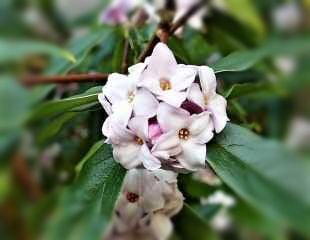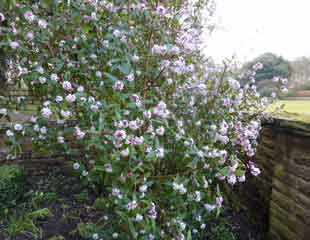

How to Grow Daphne
Daphne is a small to medium-sized shrub which flower in winter and early spring. They are attractive to grow because of their strong, sweet scent and attractive red, pink and white flowers. There are varieties of Daphne which are both evergreen and deciduous. For example, commonly grown is Daphne odora, which is evergreen. Equally popular is Daphne bholua 'Jacqueline Postill', which is deciduous. What is common to all Daphnes is the strongly scented flowers.
Daphnes have attractive foliage and some with variegated leaves, as in the image above right. Because Daphne has an intense scent and often blooms in the late winter when less of the garden is accessed, you should plant Daphne near a path to enjoy the scent. The Daphne in the centre image was growing near a sheltered wall alongside a path. The fact that it was in a sheltered spot may well account for its success, both in terms of size and the number of blooms on the shrub.
Where to plant Daphne
Although most varieties are hardy, Daphnes will only thrive in a sheltered spot and grow more reliably in the South and West. D. Odora, the Daphne illustrated above left is the most hardy, H4 which is -5-10 although much depends on the position of the plant. Daphne is difficult to graft and propagate, which means they are difficult to produce. As a result, the shrubs are more expensive than some other shrubs. Given the expense, and that Daphnes are tricky to grow, it is important to plant the right place.
Daphnes like moist but well drained soil and will not tolerate either being water logged or drought. Daphnes grow best on a neutral to slightly alkaline soil, and if it is sandy add organic matter. A heavy clay soil may not be ideal and the most tolerant of clay soil are Daphne laureola and D. Mezereum.
All Daphnes will do best in a sheltered spot with sun, although D. laureola will tolerate shade. Daphnes are not suitable to grow in container and dislike being pruned. Avoid pruning unless absolutely necessary and then only after flowering. Daphne is slow growing shrub, it can take 7-10 years to reach mature size and then only around 3-5 feet depending on the variety. Daphnes are mostly winter or spring flowering.
It is important to plant Daphne in the correct place as Daphnes do not tolerate being moved, so choose the best, sheltered spot at the outset.

Daphnes are slightly tender, and do require a sheltered spot, and the correct soil, which makes them a bit tricky to grow. Amber wheelbarrow means medium difficulty to grow.
Suggested Good Varieties of Daphne to grow
When selecting a Daphne for your garden, picking a variety which has the RHS award of garden merit is always a good starting point.
Daphne x burkwoodii is one of the easiest to grow, 'Somerset' a tried and tested variety, hardy and flowering late spring.
Daphne Odora 'Aureomarginata' very scented, late winter and early spring flowering, with some variegation on the leaves.
Daphne 'Jacqueline Postill' is evergreen and very fragrant, but may need winter protection being borderline hardy.
If your garden presents with the right conditions and soil, Daphne is a lovely scented slow-growing shrub.
If you would like to grow something a bit special, Crocus have an outstanding collection of fragrant Daphnes, including those mentioned above (affiliate link)
